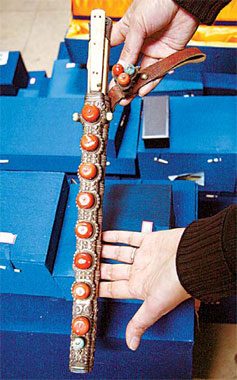Tibetan treasures to get tailor-made home
By Zhu Linyong (China Daily)
Updated: 2008-04-16 07:15
Updated: 2008-04-16 07:15
"With the help of veteran designers and engineers from institutions such as the Hua'nan Architectural Design Institute of China and folk artists from Tibet, the museum will be built and decorated in a classical Tibetan style," she said.
 A Tibetan sword decorated with jade. [China Daily] |
"But it will also be equipped with state-of-the-art facilities and be run by a team of experienced staff."
About 20 experts in cultural heritage and ethnic culture are currently helping with the appraisal, selection, collection, maintenance and arrangement of the exhibits, Zhang said.
The research center has been collecting art pieces and documents for the museum for several years.
So far, it has accumulated about 1,000 items including books, documents, photographs, Tibetan Buddhist statues, musical instruments, clothes, pottery, opera masks, Tangka paintings and even a collection of ancient medical equipment.
The oldest of the more than 60 Tangka paintings date back to the early Ming Dynasty (1368-1644), Zhang said.
However, "to enrich our collection, donations from both domestic and overseas individuals and organizations are warmly welcomed", she said.
Already, Wang Jianzhi from Hong Kong and Li Yizhi from the mainland have agreed to donate Tibetan artworks and ancient documents from their collections, Zhang said.
The most eye-catching of Wang's donations are a collection of ancient Tibetan coins and inscribed wooden slips featuring Tibetan characters from the Tubo Kingdom period (about AD 629-840).
Among the items from Li's collection is a centuries-old Buddhist sutra text inscribed on a piece of birch bark, Zhang said.
Discussions are ongoing with several other collectors, she said.
"We would also be very happy for collectors from home and abroad to exhibit their collections here at the museum so visitors can share their passion for splendid Tibetan culture," Zhang said.
Last year, the museum's preparation office commissioned several videos to be shot in Tongren county of the Huangnan prefecture in Qinghai province about how veteran Tangka painters Niangben and Renqingjia created their masterpieces.
Lu Jun, a researcher who supervised the shooting of the video, said a single 2 m by 2 m Tangka painting made with natural pigments can take more than two months, said.
"The new museum will add to the cityscape of the Chinese capital and provide museum-goers with the chance to see some truly unforgettable exhibits," Zhang said.
|
||
|
||
|
|
|
|

